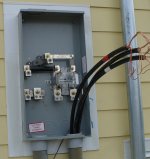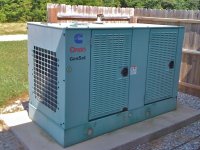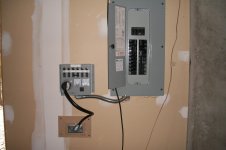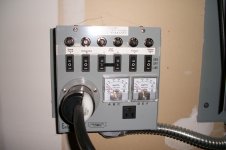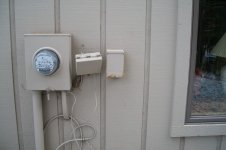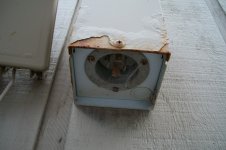tsteahr
Gold Member
- Joined
- Jul 22, 2008
- Messages
- 432
- Location
- CT shoreline
- Tractor
- Massey Ferguson GC2410tlb w/ R1 and Rimguard
tsteahr:
"If you use a three pole switch you break the neutral along with the two hots and you are totally isolated (because the utility only consists of three conductors). As to the ground, in my area there is no utility ground. The ground is just that, a wire connected to copper rods driven into the ground outside the house. I used three ground rods although only two are required by code here. The genset ground is connected to the same ground as the main panel ground. All grounds in the house must be tied together. It would be against code to have multiple ground paths in my area."
You are correct, I had overlooked that as a possibility as it is very rare, although isolation of the "grounded conductor" or neutral is a requirement in only a few places. So assuming this switch is placed between the transformer and the service entrance appliance and that no grounding path exisits betwwen the cabinent of the transfer switch and the transformer, then it is possible to achieve isolation from the utility. The multiple ground I was referring to in my e-mail is a reference to the fact that in most cases (other than the one I just mentioned) the ground is bonded to the neutral. If the utlility neutral somehow gets energized, the ground is also energized, so isolation is not achieved in that case. By the way, in the case of a commercial emergency power backup, the genset often does carry its own ground, by code. However, you are also correct in that in most situations, not all, multiple grounds are a no-no.
As to the matter of bonding the neutral and the ground mentioned in several posts (not yours tsteahr), the 2008 NEC is crystal clear, the neutral and ground are bonded once within the service entrance applicance, in all subsequent panels they are to be isolated. Theoretically this provides a fully redundant fault path to ground. It is correct that in all subsequent subpanels the ground and the neutral (now called the "grounded conductor" in the NEC) are to be fully isolated from each other.
Few of the ATS devices discussed in this thread are triple pole to allow the neutral to be isolated from the utility. If for some reason the neutral from the utility becomes energized, so does the neutral throughout the circuit system, except that it should be driven to ground through the bond in the service disconnect panel. To be clear here, that event does not cause a potential harm to a lineman from someone running a generator. A fault that is not grounded through a proper neutral/ground bonding system however, could be a hazard to a lineman.
I recently installed a fully interlocked transfer switch in my house. Like many posts here I formerly back fed the panel through a 30 amp breaker and turned off the main breaker. I trust myself to do that correctly and not put anyone at risk. I used a special set of wires and recepticles to avoid any charged male prongs, not good. However, I am now travelling alot. Last two times I have been on the road we lost power. Wife did not know how to set up portable geenrator. So I have since cured that problem with a safe, foolproof, fully interlocked, up to code system so that when the power goes out she can fire up the gen set (I even bought a new one that is electirc start) and have power in the house. I have 11 circuits in total that can be operated from this subpanel either with utility power, or the genset. Works like a charm, as I had to use it three days last week when we lost our power. I have one more enhancement to add and that is an indicator light on the utility line to make it easy to tell if power is back on.
I wish I knew how much it actually costed me to install. Good heavens copper wire is nearly as valuable as gold. Cheaper by the spool, especially if you have future use for the surplus, which I do. But $235 for 500' of AWG 6/19 is just plain crazy!
This has been a really good thread and I hope information here encourages people to install safe gen transfer switches. I do not know about anyone else, but I could never forgive myself if I accidently eloctrocuted a lineman trying to restore power to my neighborhood.
Thanks for clearing that up. What you describe makes perfect sense.
When I installed my transfer switch, I also installed a audible indicator to tell me when the utility power is back on. It is a battery powered gadget that has a sensor wire that is wrapped around one of the hot utility leads inside the transfer switch. When the power goes out I turn this little gadget on. When the utility power comes back it starts beeping. It is loud enough I can hear it in the house. My transfer switch is in my garage and I have this device mounted to the switch cabinet. I shut the device back off when the utility power come back on. It runs on a 9v battery.
Reliance THP108
